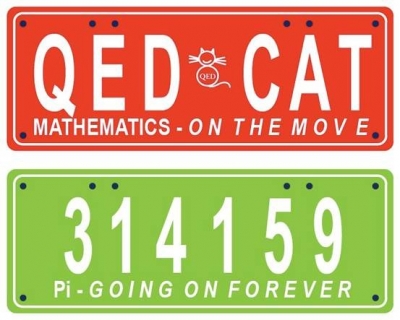VicRoads vs. Pi
by Burkard Polster and Marty Ross
The Age, 15 March 2010

The writers of the national mathematics curriculum may not consider that π is worthy of a single mention, but we still believe that it is a rather important number. And to ensure that π is suitably honoured, we had a great idea of how to celebrate yesterday's Pi Day.
We'd been pondering number plates at www.vplates.com.au, checking combinations of letters and numbers, to see whether the corresponding plates were still available. Of course, the first combination we typed in was 314159. Alas, someone had grabbed a piece of π before us!
Next, we tried the beginning of Euler's number, e = 2.71828. And that plate will be available - for a trifling $10,000. Who would have guessed Euler had such wealthy fans?
In fact, all numbers from 1 to 285,000 are classified by VicRoads as 'Heritage Plates'. All numbers above 100,000 cost $10,000 each, and the lower numbers are only available by auction. So many favourite numbers, such as e and √2 and the golden ratio, are just a little too pricey for your humble Maths Masters.
But then we had a great idea: let's change the base! After all π is 3.14159... simply because we're thinking in base ten. But as a binary number, π becomes 11.0010..., and in base three we have π = 10.0102... .
Those bases still result in π being a heritage number. But, in base four we have π = 3.02100..., and this number is still available. The same is true for π written in bases from five up to nine. There is also no reason to stop with base nine, and there is actually a reason to go further: the larger the base, the better the approximation of π given by the first six digits.
Of course to write π in something like base fifteen, you need more than the usual 10 digits. But any symbol can be used as a digit, and in particular letters can. It is in fact common to use A to stand for the number 10, B for eleven, and so on. Then, for example, π in base fifteen is written 3.21CD1... .
Using letters together with the standard digits, we can go all the way up to base 36. We can even go beyond base 36, as long as we're lucky. We can think of zero to nine and A to Z as the first 36 digits in any given base. Then we can still write the expansion of π in that base, just as long as the digits needed are each less than 36.
It turns out that for π number plates, the largest we can go is base two hundred and thirty-four. Written in this base π = 3.XVBIY..., which is actually a big improvement over the traditional 3.14159: converting 3.XVBIY into a decimal number, it agrees with π up to the twelfth decimal place.
Success! We've determined our optimal number plate, and it won't cost us a fortune. We excitedly type in our choice, and .... Sorry! This plate combination is not a valid number. Alas, there is a rule that a custom plate that starts with a number cannot contain letters as well. Foiled by VicRoads!
This means that the best we can do with six digits is base twelve, giving π = 3.18480.... It still results in an intriguing π plate, a good tribute to Pi Day, but it's not the one we really want!
Puzzle to Ponder
Feel free to email us with your suggested solutions. Later in the week we'll post our solution in the comments section. Please also email us if you wish to be added to our email list.
Below are two famous riddles (among mathematicians). Can you explain them?
There are 10 kinds of people in the world: those who understand binary numbers, and those who don't.
Why do mathematicians confuse Halloween and Christmas?
Copyright 2004-∞ ![]() All rights reserved.
All rights reserved.